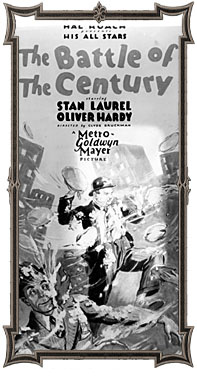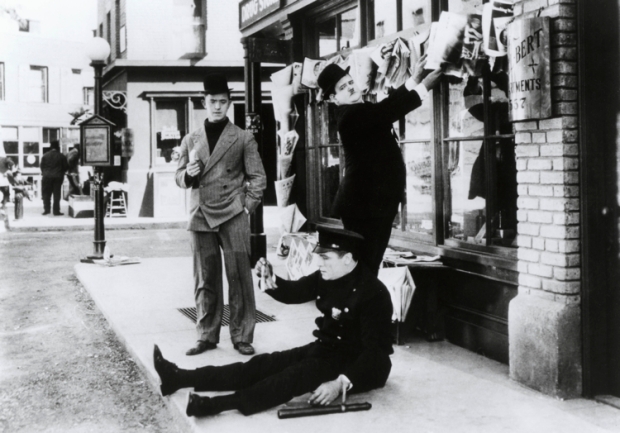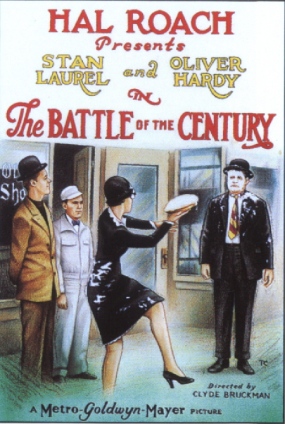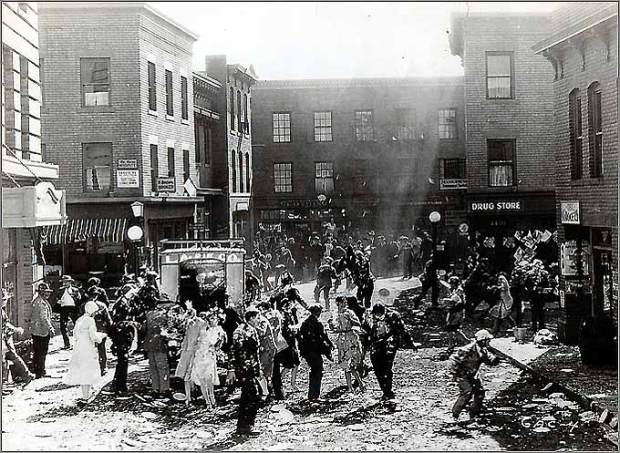— A belated report on a screening of the restored ‘BATTLEOF THE CENTURY’–
Recently, happy coincidence presented the opportunity for me to see several ‘new’ Laurel and Hardy films in a short space of time. Kennington Bioscope’s Silent Laughter Weekend presented newly rediscovered footage from
‘THE SECOND HUNDRED YEARS’ as well as two L & H solo films, and shortly after came the chance to see the newly restored, almost complete version of ‘THE BATTLE OF THE CENTURY’. For so many years a frustratingly fragmented film, this has finally had its iconic pie fight reinstated at full length. Re-premiered last year, the film has, I believe, only had two previous screenings in the UK, both in London, and both of which I was crushingly unable to attend. It was with great excitement that I saw the film was being shown as part of the Leeds International Film Festival, in support of Harold Lloyd’s wonderful ‘SPEEDY’.

The venue was The City Varieties theatre, a Victorian marvel which, like the films, has been newly restored to its former glory. It was also an appropriate venue for a silent comedy show, as both Chaplin and Keaton once trod the boards here (Chaplin as a young performer, Buster in his later years).
Accompaniment was by Jonathan Best and Trevor Bartlett. Their accompaniment, of piano and percussion, was magnificent, one of the very best I’ve heard.
And the films? ‘SPEEDY’,
my favourite Lloyd feature, was wonderful as ever, and shimmered magnificently in its new Blu Ray version. As good as it is though, ‘THE BATTLE OF THE CENTURY’ was inevitably the big star here. The restoration looked absolutely beautiful on the big screen, and I found myself in a childlike state of excitement and wonder as the new footage unfolded.
We’ll get to the prodigal pie fight in a minute, but first, a word on the opening scenes.
The boxing scenes looked stunning, much less dark than the previously available version. Comedically, I’ve always thought this a very underrated sequence: some nice physical comedy, superb ‘heavy’-ing from Noah Young, and wonderful reactions from both Stan and Babe. It’s also a rare foray into topical satire, albeit loosely, for L & H. ‘The Battle of the Century’ was how the 1927 Dempsey v Tunney prize fight was billed, and it became notorious for its ‘long count’. The Chicago Tribune takes up the story:
“Amid a screaming crowd of 104,943 spectators, reporters at ringside said it took champion Gene Tunney somewhere from 12 to 15 seconds to regain his feet after being knocked down byformer champion Jack Dempsey.
It should have taken referee Dave Barry 10 seconds to count out Tunney, making Dempsey a winner by a knockout in the seventh round. But Dempsey ignored the rule that he first had to go to a neutral corner. He thereby transformed those few seconds into legend.Barry escorted Dempsey to a corner, then began a delayed count. Tunney rose before it reached 10.
In his autobiography, Dempsey conceded that he forgot all about the rule: “It’s hard to stop what you’re doing, standing over a guy and waiting for him to get up.”
Tunney, who floored Dempsey briefly in the ninth round, won the 10-round fight and retained the title.”
So, actually, the whole scene is a directly comic version of the real life event. It also struck me while watching the prizefight scenes that this is where ‘Stan’ is really born. While THE SECOND HUNDRED YEARS and PUTTING PANTS ON PHILIP were both wonderful comedies with terrific performances from Laurel, he’s a bit too spirited and spritely in both to fully represent the later Stan we know and love. Perhaps the mellowing was present in ‘HATS OFF’, too, but the surviving still photographs and cutting continuity cannot reveal whether the nuance of performance we see in ‘BATTLE’ began in the earlier film. Until that magical date when we can see ‘HATS OFF’, ‘THE BATTLE OF THE CENTURY’ represents the real birth of ‘Stan’.
With the boxing scenes over, the sense of anticipation rose in the audience. The scene which followed, with insurance man Eugene Pallette persuading Babe to take out some insurance on Stan, is still elusive. It was replaced by the same selection of bridging title cards and stills we’ve always been familiar with. But then, the last still faded, there was a brief, pregnant pause, and up in silver light shone a different corner of the Roach studios. Our two heroes walked into the frame and it was true. This was something I’d never seen before!

Here they were, bringing to life images we’ve previously only known as still photographs, lost frozen images in books. Here was Babe, imperiously leading the way, and sneakily dropping a banana peel ahead of Stan; here was Stan, walking right over it in bland-faced, blissful ignorance. It was really happening. The whole scene was very well developed as a comic sequence. Feigning indecision over which direction to take, Babe repeatedly leads Stan for a walk back and forward along the same small piece of street. Each time, he gets to subtly shows his frustration with an understated “Damn!” gesture. Wonderfully funny underplaying from Mr Hardy.
Eventually, it is not Stan but a cop who slips on the peel. This begins a running gag of Babe trying to plant the rest of the banana on Stan. When he finally succeeds in doing so, the scene plays out beautifully slowly, a fine example of the L & H breakthrough in pacing. The cop looks at the banana, then at Stan. Stan looks at the banana, then back at the cop. The cop removes Stan’s hat, which Stan looks at curiously. Then, and only then, does the cop exact retribution on the Laurel cranium. Stan continues playing the scene slowly, glazing over and replacing his hat. Finally, he begins to cry. Early in the game of the L & H characters, the cry is set up wonderfully; there was not just laughter but real sympathy in the audience at Leeds!
Babe investigates the damage; a large lump has risen on Stan’s head. “I’ll get $100 dollars for that pineapple!” he crows. Stan, like Harry Langdon, seeks solace in food, but Babe snatches the banana from him before it can reach his mouth. This leads us into where the existing footage previously picked up: Pieman Charlie Hall slipping on the peel and Babe trying to plant the peel back on Stan. However, it soon becomes clear just how much Youngson edited down the footage. Practically every sequence or shot we’re used to has at least some extra material to it, in many cases full omitted gags. Careful examination of the film shows the joining points, as the ‘new’ footage is just a tiny bit less sharp.
The initial altercation with Charlie Hall, for instance, reinstates a previously unknown tit for tat sequence with ‘the little menace’. After Babe (this time unsuccessfully) again tries to plant the peel on Stan, Hall flicks his nose, messes his tie, and generally gives him a classic, finger-wagging Hall telling off before resorting to a pie! It’s easy to see why Youngson edited this down after dispensing with the previous scene: it works much better in the context of Ollie getting his come-uppance after leaving poor Stan at the mercy of the policeman.
After this, Dorothy Coburn receives Babe’s pie and marches over, demanding, via title “Who threw that poultice?” She returns the favour, after Stan has carefully moved Hall out of the way.
Youngson’s footage has some judicious edits from this sequence, including the disappearance of the moment where Stan receives a pie of his own.
Also now reinstated is the reappearance of the insurance salesman, who cries out “Don’t you know it’s foolish to throw pies without insurance?”, and is roundly pelted.
Added to the recipients of pastries are a chairwoman beating a rug (“Who threw that goober?!”), and several others. We’ve already seen a man receiving a pie on his freshly shined shoes; now, the shoeshine man also gets a delivery of his own. Ditto, the photographer whose subject is a victim. In the bakery, we see a customer make the demand , via title card, “Gimme a pie!”, before his wish is fulfilled. These little details, previously lost, add a great deal to the previously known footage. Without trying to sound pretentious, the sequence now flows much more organically, as the filmmakers intended it to be seen. Laurel’s later observation that they “made every pie count” stands truer than ever and the even greater plethora of variations on the gag is increased testament to the gag writers’ talent.
Of course, one of the most justly celebrated gags in the whole thing is a cameo by Anita Garvin. Recalling that she did it as a favour to Stan on his lunchbreak, it’s a testament to her talent that she can make a quick, off the cuff shot perhaps the funniest moment in the picture. Falling on the ground, the pie landing beneath her skirt, she registers shock, disgust and embarrassment all at once in a marvellously subtle facial expression, before getting up awkwardly, and pausing to shake her leg ever so gently to dislodge some pastry. This is where the previous version ended, but the celebrated scene now has a tag – we cut back to the boys, having seen her, laughing away, and Stan even imitating her leg waggle. At this point, the cop re-enters.
“Did you start that pie fight?” He asks.
“What pie fight?” asks Babe, his face a picture of earnest and cherubic helpfulness beneath the pastry; cut to the view of the entire city block consumed by the ritualistic pastry orgy.
Right on cue, a pie lands square in the cop’s face. The boys stifle a laugh, and attempt to saunter nonchalantly off, but turn to running as the cop gives chase. Fade to The End title, and it was all over too soon.
In an age of DVD box sets, eternally cycling YouTube playlists and instant availability of classic (and not so classic) film footage, it’s easy to take for granted how much we have. The discovery of small chunks of important footage like this, at a time when our L and H wish list is so mercifully small, really make us pore over them and appreciate every frame. And what a wonder it is to be treated to new scenes, rather like bumping into an old, beloved friend in the street and unexpectedly embarking on a new adventure. As such, I found it really quite moving to witness ‘brand new’ footage after all these years. Of course, it’s impossible not to be left wanting more – the one remaining missing scene from BATTLE, and of course the complete HATS OFF – but even if this turns out to be the last major L & H rediscovery, it’s a fitting jewel in the crown of their catalogue.
**By the way, you can catch the new version,of “BATTLE” at the Hippodrome Film Festival of Silent Cinema in Scotland next month, and due to demand there’s a repeat showing in April. It’s also planned to be part of the 2017 Silent Laughter Weekend. Watch this space for details!**




Would somebody please release this on Blu-Ray? Pretty please?
LikeLiked by 1 person